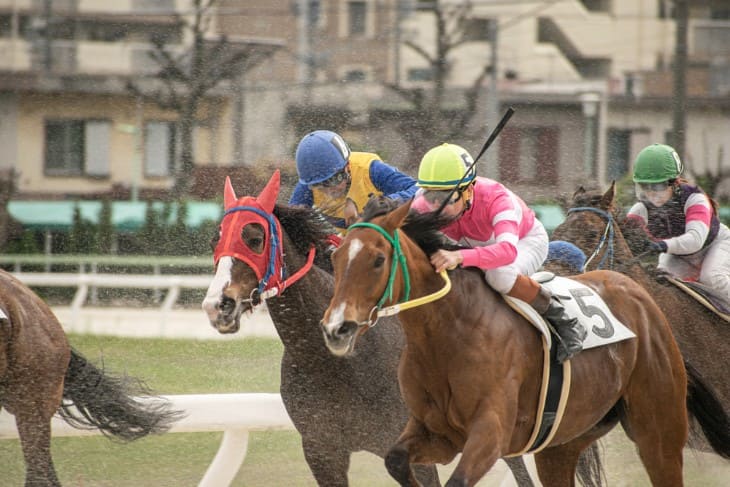- What really is RPR in Horse Racing?
- How RPR is Calculated: The Methodology Behind the Rating
- RPR’s Role in Assessing Racehorses
- Comparison between RPR and Other Rating Systems
- How RPR Affects Horse Racing Strategies and Decisions
- The Impact of RPR on Horse Sales and Auctions
- PR's Role in the Future of Horse Racing
- In Summary
Horse racing is a sport that has evolved from an activity steeped in history and tradition to a complex arena where many factors play an important role in determining how well a horse can perform. One of these elements is the Racing Post Rating (RPR), which has become a cornerstone for rating racehorses.
But, what exactly does RPR mean in horse racing and how does it affect the sport? This article explores the world of RPR by discussing its meaning, calculation, and impact on horse racing.
What really is RPR in Horse Racing?
Racing Post Ratings (RPR) are very significant measures in horse racing. It assesses racehorses’ performances helping everyone from trainers to bettors understand how well a particular horse is performing. This rating system was established by The Racing Post which is a widely-known UK publication. It has since turned into one of the key tools in this sector for assessing horses objectively.
In essence, RPR ascertains how good or bad a racehorse performs during races. It looks at the performance of each horse across different races while comparing it with other horses. Factors considered when computing such ratings include distance covered by the horse; weights carried by the horses respectively; and condition of the track among others. All these are important components used to determine RPR's position on any given animal.
The beauty of RPR is that it is not fixed but rather changes with a recent performance by horses. When a horse wins big races their RPR might go up significantly. Conversely, when over time they fail to win some races their RPR may reduce accordingly thus keeping pace with the current form of such an animal.
Racing post rating is extensively used within horse racing circles today hence trainers and owners look at them just for comparison purposes against competitors’ animals so that they can make decisions about training methods plus which stakes they should or should not enter their animals into while betting enthusiasts also use the ratings to make judgement on which horse to back by use of RPR because if horse has high rating means it has been performing well hence it is high probability to be a good bet.
It shows how good or bad a particular animal is; that is what makes it easier for all stakeholders in this game to make decisions based on knowledge. If you are involved in the racing industry either as an owner, trainer, gambler or just a fan, RPR is one concept that you cannot ignore as far as understanding horse racing is concerned.
How RPR is Calculated: The Methodology Behind the Rating
- Racing Post Rating: The analysis of race performances forms the basis for RPR. Each race performance by a horse is scrutinised and compared with other horses that participated in the same event. To come up with an accurate rating, analysts from Racing Post look at how a horse runs each time they enter into a competition. They take into consideration the level of competition, state of the track and whether horses coped with given race conditions amongst others This depth evaluation helps create an exact image of the ability and form of these animals.
- Various Factors to Consider: Calculating RPR involves several factors. These include how far the race was, the burden of the horse and the condition under which the race took place. A horse's performance can be influenced by the distance of a race seeing that some horses are better at longer distances, whereas others excel in short races. Similarly, the weight carried has a major impact since carrying extra weight is a disadvantage.
- Dynamic and Up-to-date Rating: RPR is not static as its rating keeps changing after every new performance by a horse. It can therefore have higher or lower ratings depending on how it performs in its last few races. Being dynamic means RPR is always up-to-date reflecting a horse's current form. And when it does this the rating will rise accordingly if indeed there is any evidence of improvement in that horse's racing record.

RPR’s Role in Assessing Racehorses
- Evaluation Tool for Trainers and Owners: RPR serves as an important evaluation tool used by trainers and owners to assess their horses' abilities and potential. Trainers and owners depend on RPR to help them ascertain where their horses stand relative to those of other competitors. The evaluation indicates how well a horse has performed, this information is invaluable for decision-making regarding training programs as well as races.
- The Guide for Bettors Making Informed Decisions: For punters in racetracks across Europe, RPR holds considerable sway over their choice of bets on individual nags standing at starting stalls; one with higher RIR might be worth giving money away on it as being relatively successful so far – betting addicts often use this technique instead relying on Racing Post Ratings while placing stakes upon certain runners having gone over past results produced within different courses. This assessment reveals what condition a runner is currently in before going into any upcoming event thereby increasing its chances overall.
- Insight for Fans and Enthusiasts: Moreover, people who follow the races can gain insight from this rating system as well. The RPR or Racing Post Rating System provides a richer understanding of racing. Fans can track their favourite performances with RPR. It also helps in understanding the competition and appreciating the details behind horse racing.
Comparison between RPR and Other Rating Systems
In horse racing, several other rating systems are used to evaluate racehorse performance, each having its own approach and focus. This is one of many rating systems for racehorses called the Racing Post Ratings (RPR) but it is not the only one. A comprehensive view of a horse's ability can be obtained by comparing how much RPR differs from others like Official Handicapper's rating and Timeform rating.
The Official Handicapper's rating, managed by the British Horseracing Authority (BHA), is another widely recognized system. This ranking depends on performances while participating in races; however, it has a different focus, unlike RPR. Moreover, this handicapper system mainly handles weight allocation among horses at handicap races to create fairness.
On the other hand, Timeform is a proprietary rating system developed by Timeform – an established publisher within the industry that covers all aspects related to equine sports including breeding programs and betting markets around them, too. As such, just like RPR, horses are ranked based on their race performances through Timeform ratings; nevertheless, these rankings typically include some qualitative content such as subjective analyst input that assesses what style of running could be expected from such animal or may even reveal potential
Each of these systems – RPR, official Handicapper’s rating and Timeform offer valuable insights into a horse’s performance. RPR is particularly appreciated for its accuracy and objectivity. It can be relied on to give a fair impression of the current form, as well as ability, of a horse. Official Handicapper’s rating is an important factor in handicapping by ensuring that the racing competition is fair. Timeform offers unrivalled quantitative and qualitative analysis providing a wider insight into the racing style and potential of a horse.
Although RPR is key in horse racing, comparing it with other rating systems allows for a deeper understanding of horses' performances. Each system has its strengths which when put together will enable you to have an all-round view of horse racing at large. Understanding these ratings can increase your love for the game whether you are a punter or trainer or even just an enthusiastic follower.
How RPR Affects Horse Racing Strategies and Decisions
- Training/Race Planning: Trainers are greatly affected by RPR when it comes to their decisions on training programs and race planning for their horses. They watch out for the RPR closely so that they can adjust their training methods according to each animal's requirements.
- Betting Strategies: For bettors, RPR is a key tool in formulating betting strategies. It offers insights into a horse's form and potential, guiding bettors in making more informed decisions. Bettors look at RPR to identify horses that are in good form or showing improvement. A horse with a consistently high RPR or one that is showing an upward trend might be a good bet.
- Breeding Decisions: RPR also influences breeding decisions in the horse racing industry. Stallions and mares with high RPRs are often sought after for breeding, as they are likely to pass on desirable traits to their offspring. Breeders pay close attention to RPR when selecting breeding pairs. A high RPR is an indicator of a horse's racing ability, and breeding horses with strong RPRs increases the likelihood of producing high-quality racehorses.

The Impact of RPR on Horse Sales and Auctions
- Determining Market Value: RPR plays a pivotal role in determining the market value of racehorses in sales and auctions. When a horse is put up for sale, potential buyers look at its RPR to assess its racing ability and potential. Horses with higher RPRs are often more attractive to buyers, as they are perceived as having a better chance of success on the racecourse. This can lead to increased demand for horses with strong RPRs, driving up their market value.
- Influencing Buyer Decisions: Buyers heavily rely on RPR when making decisions at sales and auctions. A high RPR can be a strong incentive for buyers to bid competitively on a horse. Buyers view RPR as an objective and reliable measure of a horse's form. It provides them with confidence in their purchase, knowing that the horse has a proven track record of success. Additionally, RPR helps buyers make informed decisions about which races to enter their newly acquired horses, maximising their chances of earning returns on their investments.
- Enhancing Transparency: RPR contributes to transparency in horse sales and auctions by providing an objective benchmark for evaluating horses. In an industry where significant financial transactions take place, having a standardised rating system like RPR ensures fairness and transparency. Buyers can compare horses based on their RPRs, making the evaluation process more straightforward. This transparency benefits both buyers and sellers, as it fosters trust and confidence in the marketplace.
PR's Role in the Future of Horse Racing
RPR, or Racing Post Rating, is set to play a significant role in the future of horse racing. As the sport evolves, the importance of accurate and comprehensive rating systems like RPR becomes ever more apparent. RPR's ability to provide a clear and objective assessment of a horse's performance makes it an invaluable tool for all those involved in the sport.
One of the key areas where RPR will continue to make an impact is in the world of betting. Bettors rely on RPR to make informed decisions about which horses to back. The rating's accuracy and reliability give them confidence in their choices. As betting remains a central part of horse racing, RPR's role in guiding bettors is likely to grow even further.
Training and horse management is another area where RPR will continue to be influential. Trainers and owners use RPR to assess their horses' strengths and weaknesses. By understanding how their horses rate compared to others, they can tailor their training programs to improve performance. This can lead to more competitive and exciting races, raising the overall standard of the sport.
Additionally, RPR could play a role in the breeding of racehorses. Breeders may look at the RPR of potential breeding horses to gauge their racing ability. A high RPR could indicate that a horse has desirable traits that could be passed on to its offspring. This can lead to the development of stronger, faster horses, pushing the boundaries of the sport.
RPR is more than just a rating system. It's a tool that shapes various aspects of horse racing, from betting to training to breeding. As the sport continues to develop, the role of RPR in informing and influencing decisions will only become more vital. It's a key part of the sport's present and will undoubtedly be a significant part of its future.
In Summary
RPR is a fundamental aspect of horse racing, providing a clear and objective assessment of a horse's performance. It influences various facets of the sport, from betting and fan engagement to training and breeding strategies. Understanding RPR is key to appreciating the complexities and competitive nature of horse racing, making it an essential tool for anyone involved in or interested in the sport. As horse racing continues to evolve, the role of RPR remains pivotal in shaping the future of this thrilling and dynamic sport.








